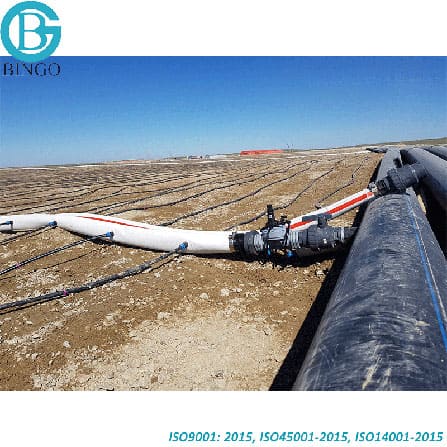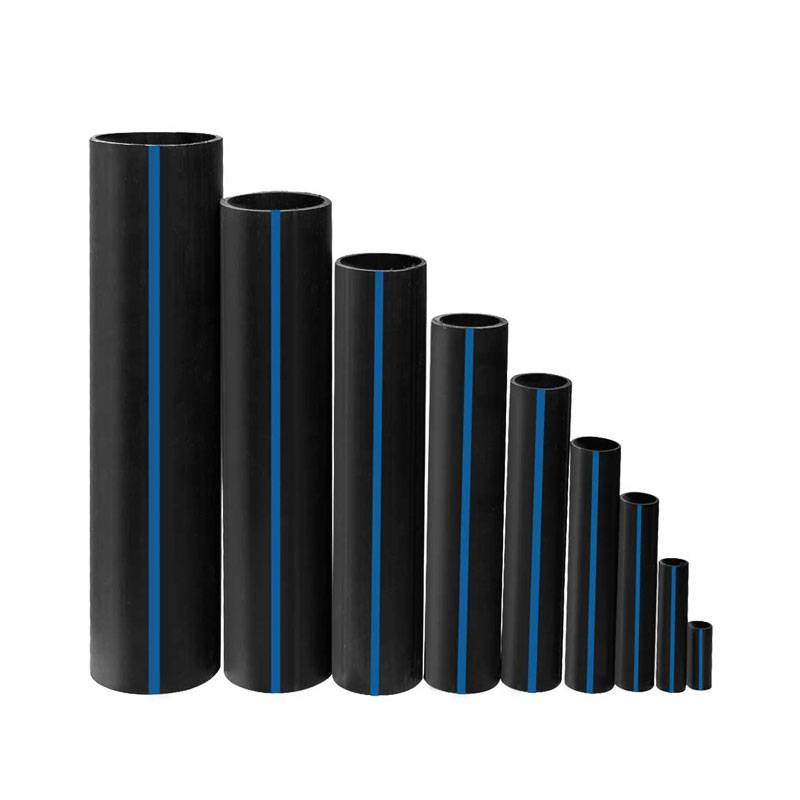Reasons Why hdpe pipe in stock Midland TX Is Essential for Local Industries
Check Out the Production Process Behind High-Quality HDPE Pipeline and Its Applications
The production procedure of top notch HDPE pipes is detailed and methodical. It starts with the selection of resources that boost efficiency. Following this, ethylene undergoes polymerization to form resin, which is then formed via extrusion. Quality control is paramount, making certain that the last item meets rigid requirements. Nonetheless, the trip of HDPE pipelines doesn't finish with production. Their applications across numerous industries reveal a broader relevance worth analyzing.
Comprehending HDPE: Features and Advantages

High-density polyethylene (HDPE) is a functional polycarbonate understood for its durability and resistance to different ecological variables. This product shows exceptional tensile stamina, making it suitable for requiring applications. Its low-density framework contributes to a lightweight item, helping with ease of handling and setup. HDPE likewise showcases remarkable resistance to chemicals, which minimizes deterioration when exposed to severe compounds.
The product's low wetness absorption better enhances its longevity, making it perfect for use in pipelines and storage space tanks. In addition, HDPE is immune to ultraviolet (UV) radiation, ensuring that products keep their stability even when subjected to sunshine. Its flexibility enables for the production of intricate shapes without compromising strength. The eco-friendly nature of HDPE, usually originated from recycled materials, includes to its charm, promoting sustainable practices in manufacturing. On the whole, these properties and advantages make HDPE a recommended choice for different industrial and consumer applications.
Resources Option for HDPE Production
The selection of resources for HDPE manufacturing is vital to confirm the end product meets the wanted specs and high quality requirements. High-density polyethylene (HDPE) is primarily created from polymerized ethylene, acquired from fossil fuels such as gas or crude oil. The high quality of these feedstocks substantially influences the mechanical and thermal properties of the final HDPE.
Ingredients likewise play a substantial duty in enhancing HDPE's efficiency, consisting of anti-oxidants, UV stabilizers, and colorants, which boost toughness and resistance to environmental factors. The selection procedure need to think about not only the chemical structure of the raw materials however additionally their processing attributes to ensure reliable manufacturing.
Moreover, the sourcing of basic materials must prioritize sustainability and compliance with ecological laws, as accountable practices are imperative in today's market. Inevitably, mindful raw product selection lays the foundation for creating high-quality HDPE pipes suitable for diverse applications.
The Extrusion Refine: Shaping HDPE Pipeline
The extrusion procedure plays an important role fit HDPE pipelines, starting with thorough product preparation techniques that ensure ideal circulation and consistency. Just as vital is the style of the die, which straight influences the last dimensions and surface quality of the pipe. Together, these elements add considerably to the performance and quality of HDPE pipe manufacturing.
Product Prep Work Techniques
Effective manufacturing of HDPE pipes starts with careful product preparation strategies, especially the extrusion procedure. Throughout this stage, high-density polyethylene resin is very first dried to remove dampness, guaranteeing suitable circulation characteristics. The material is then fed right into the extruder, where it undertakes heating and melting, changing right into a viscous state. This heating procedure is carefully controlled to preserve the material's stability and performance. The liquified HDPE is compelled with a die, shaping it right into a constant pipeline form. Appropriate temperature administration throughout extrusion is vital, as it straight affects the product's residential properties and the end product high quality. Once shaped, the HDPE pipeline is cooled down and cut to specified sizes, all set for succeeding handling and applications.
Die Design Relevance
Accuracy in die style plays an important duty in the extrusion procedure of HDPE pipes. The die functions as the final shaping tool, directly affecting the pipeline's measurements, wall density, and surface area coating. A well-designed die guarantees consistent material circulation, lowering flaws such as abnormalities and weak points. The geometry of the die must be optimized to suit the particular residential properties of HDPE, including its viscosity and thermal behavior during extrusion. In addition, the cooling price of the product as it goes through the die can substantially influence the pipeline's architectural honesty. As a result, investing in innovative die innovation is essential for suppliers aiming to produce premium HDPE pipelines that fulfill market criteria and client expectations.
Quality Assurance Procedures in HDPE Production
Although different variables affect the high quality of HDPE pipeline manufacturing, reliable quality assurance procedures are important to assure uniformity and dependability in the final item. Trick quality assurance methods include extensive product inspection, validating that the raw polyethylene satisfies established criteria for pureness and density. Throughout the extrusion process, specifications such as temperature level, stress, and cooling time are closely kept an eye on to keep dimensional precision and architectural integrity
Additionally, post-production testing is vital; makers often perform hydrostatic examinations to analyze the pipeline's strength and resistance to pressure. Aesthetic evaluations for surface area problems better boost quality control. Accreditation from pertinent requirements companies, like ASTM or ISO, provides an additional layer of trustworthiness. By applying these thorough quality assurance measures, manufacturers click here can reduce defects, improve efficiency, and guarantee that the HDPE pipes satisfy the details requirements of various applications, inevitably leading to customer complete satisfaction and count on in the item.
Applications of HDPE Pipe Across Industries
HDPE pipes are utilized across various fields because of their toughness and versatility. In water circulation systems, they guarantee reliable shipment, while in wastewater management, they supply dependable services for waste transportation. In addition, agricultural watering networks benefit from HDPE's resistance to deterioration and versatility, making it a perfect choice for modern-day farming practices.

Water Circulation Equipments
A considerable number of sectors count on high-density polyethylene (HDPE) pipes for efficient water distribution systems. Recognized for their durability and resistance to corrosion, HDPE pipelines are commonly made use of in local water networks, agricultural irrigation, and industrial applications. Their lightweight nature promotes simple handling and installment, minimizing labor prices and time. In addition, HDPE pipes can suit various stress levels, making them ideal for both reduced and high-pressure systems. custom hdpe pipe manufacturing Midland TX. The versatility of the material permits seamless integration into existing facilities, minimizing the need for considerable excavation. Additionally, HDPE's resistance to chemical seeping warranties that the water supplied stays risk-free and tidy, making it a suitable option for preserving the high quality of drinkable water across various markets
Wastewater Administration Solutions
Efficient water circulation systems additionally lead the way for cutting-edge wastewater management remedies, where high-density polyethylene (HDPE) pipes play a considerable duty. Renowned for their sturdiness and resistance to rust, HDPE pipelines are optimal for moving wastewater in different settings. Their adaptability permits very easy setup in complex environments, decreasing the requirement for substantial excavation. Additionally, HDPE's smooth interior surface area reduces rubbing, enhancing circulation prices and effectiveness. These pipes are additionally immune to chemical leaching, ensuring that impurities do not compromise the surrounding atmosphere. Industries, communities, and treatment centers progressively rely on HDPE pipes for their integrity and durability, making them a recommended option for modern-day wastewater monitoring systems. This versatility emphasizes the critical significance of HDPE pipes across countless applications.
Agricultural Irrigation Networks
Agricultural irrigation networks benefit substantially from the use of high-density polyethylene (HDPE) pipes, which give effective and reliable water shipment to plants. HDPE pipelines are lightweight, making them very easy to move and mount, while their adaptability enables numerous setups in diverse terrains. These pipelines demonstrate excellent resistance to deterioration, chemicals, and UV radiation, making sure longevity in rough agricultural atmospheres. In addition, their smooth interior surface minimizes rubbing loss, optimizing water circulation and minimizing energy prices connected with pumping. The durability of HDPE pipelines, usually going beyond half a century, adds to lower upkeep and substitute expenditures. Farmers progressively count on HDPE pipelines to enhance irrigation efficiency and advertise sustainable farming techniques, inevitably leading to improved crop yields and resource conservation.

Future Fads in HDPE Pipeline Modern Technology
As the demand for lasting and reliable infrastructure expands, advancements in HDPE pipe technology are positioned to transform numerous sectors. Arising trends consist of the combination of smart innovations, such as sensors and IoT capabilities, which help with real-time monitoring of pipeline conditions, lowering upkeep expenses and protecting against leaks. Furthermore, the growth of sophisticated manufacturing techniques, such as 3D printing, is making it possible for the manufacturing of complex, customized pipe styles that cater to certain project demands.
The emphasis on recycling and round economic situation techniques is driving the development of HDPE pipelines made from recycled products, boosting sustainability. Boosted jointing approaches, such as electro-fusion and mechanical fittings, are likewise enhancing installation performance and dependability. Finally, the expanding emphasis on ecological laws is pressing producers to embrace greener production processes, making certain that HDPE pipelines not just meet sector criteria however likewise promote an even more sustainable future for facilities development.
Often Asked Questions
Exactly How Does HDPE Compare to Various Other Plastic Products?
HDPE outmatches several other plastic materials regarding toughness, chemical resistance, and adaptability. Its low density and high tensile stamina make it excellent for different applications, typically exceeding alternatives in both efficiency and longevity.
What Are the Ecological Effects of HDPE Production?
The environmental influences of HDPE manufacturing consist of greenhouse gas exhausts, energy intake, and possible pollution from manufacturing procedures. Furthermore, incorrect disposal can bring about dirt and water contamination, increasing problems regarding lasting eco-friendly impacts.
Can HDPE Pipeline Be Reused?
Yes, HDPE pipes can be reused. Numerous facilities accept made use of HDPE for processing, transforming it into brand-new products. This reusing adds to sustainability initiatives, lowering plastic waste while conserving resources and power in the production cycle.
What Is the Lifespan of HDPE Pipeline?

How Do Temperature Variations Impact HDPE Pipe Performance?
Temperature variants substantially impact HDPE pipeline performance, affecting versatility and stamina. Heats can lead to softening, while low temperatures might cause brittleness, inevitably affecting the pipeline's toughness and viability for various applications in varied atmospheres.